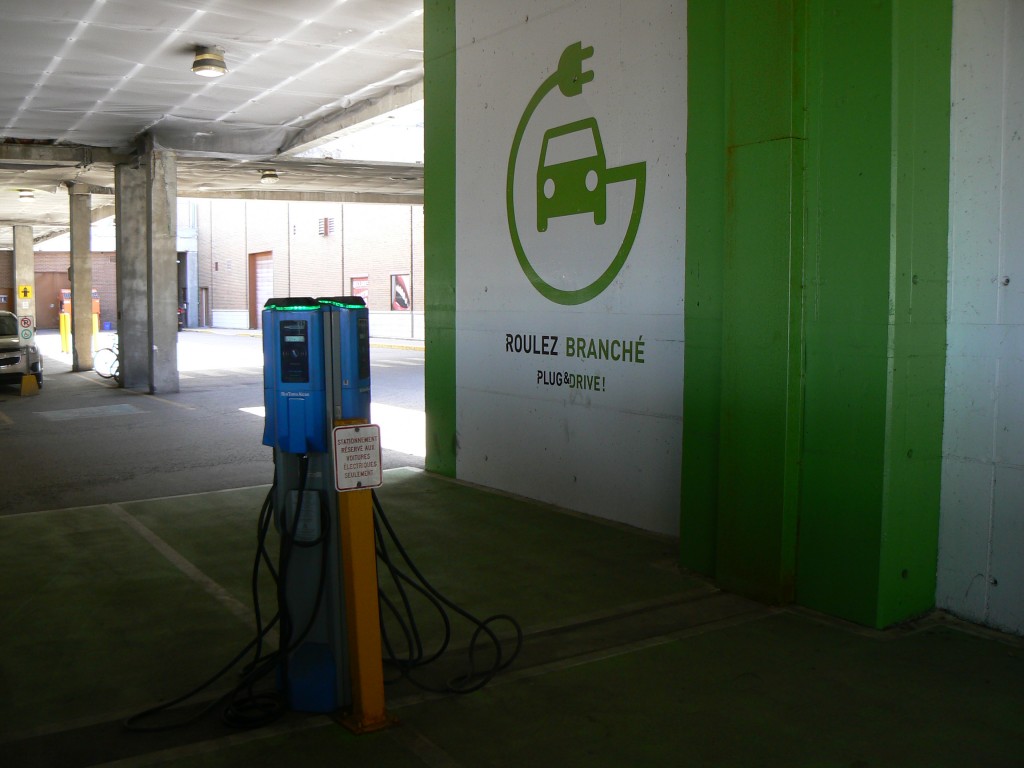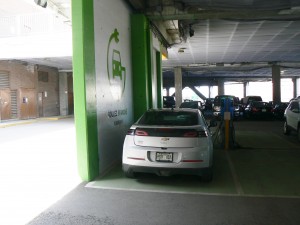Not the Netherlands: electric vehicle charging stations in Quebec and Ontario

The Plug and Drive electric vehicle charging station in the parking garage at Les Galeries de Hull mall in Gatineau, Quebec. The station allows four cars to charge at the same time. Photo by James Morgan
Recently, the government in The Netherlands decided to begin steps to end the sale of fossil-fuel powered vehicles in that country by 2025 and go all electric. This is a pretty ambitious plan for any country to take on, even if it is a small country. The Netherlands is only just over 16,000 square miles, a little more than 41,000 square kilometers. The irony is that most of the electricity in that country is generated by burning coal–a pollution-causing fossil fuel, and it’s also home to Royal Dutch Shell, the second-largest oil company in the world. However, going to all electric vehicles will be a lot easier in a small European country where car ownership is lower than in North America, and there is already a good passenger rail service.
A transition to all-electric vehicles in Canada or the USA would be much more difficult. The huge land areas of both countries, the lack of a strong power grid in parts of them, and the fact our passenger rail systems are severely inferior as alternatives to driving are among the biggest challenges. And, let’s not forget that in this part of the world, we still seem to like big things powered by gasoline and diesel, even though cars today are certainly smaller and more efficient than they were three or four decades ago.
How easily could North Americans adapt to all-electric vehicles? Making them isn’t a problem, auto manufacturers are already in the business. Having enough places to charge them is the real challenge. Like gas stations, charging stations need to be located in places where people will need them. The Canadian Automobile Association (CAA, the Canadian partner of the AAA), has a search app on their website for charging stations. I entered my postal code (Canadian zip code), and watched the results appear on a map. I noticed a few differences among the results on either side of the Ontario-Quebec boundary. Stations on the Quebec side are located in places more accessible and practical to the general public, including Gatineau’s two largest shopping malls. There are no charging stations at any of Ottawa’s three major shopping malls—two of which are located by a major highway. The only station in the By Ward Market area is in a city-owned parking garage which is currently closed for several months for renovation. None of the major downtown hotels in Ottawa have charging stations either. For those who work downtown, there are just a couple of charging stations in two or three government office buildings. One of the Ottawa locations however does make sense, it’s at a car dealership.
Quebec is ahead of Ontario when it comes to developing electric vehicle charging stations. There are approximately 800 of them across Quebec, provided by the provincial government and Hydro-Quebec. Electricity is cheap and in abundant supply in Quebec, so providing a strong network of charging stations isn’t too much of a challenge. In Ontario, things are a bit more complicated. Power there is much more expensive, in shorter supply, and the distribution systems are now mostly under private ownership. The Ontario government is trying to catch up to Quebec. The Ministers of Transportation and Environment just announced a plan to create 500 more charging stations at 250 locations across Ontario in 2017. It’s an ambitious, but necessary objective in Ontario, the most populated province of Canada where pollution-producing cars jam the highways in the Toronto area. The Ontario plan also aims to put more charging stations at workplaces and residential buildings.
While small countries like The Netherlands with a less automobile-oriented culture might have an easy time achieving their target of all-electric vehicles by 2025, a lot of work still has to be done to make vehicle charging accessible in both public and private places in North America. Even within Canada, as the differences between Quebec and Ontario show, there are inconsistencies in charging services between provinces and cities.
Tags: canada, electric vehicles, environment, Ontario, Quebec







.png)

…Thought… And how hard would it be to build these charging stations for the wave of electric vehicles that are going to be everywhere in the next 10 yrs. here in the U.S. , Right here in Massena or at least start the training of building these at the local Boces .Just so when the time comes we don’t have to order out for them …?
An excellent thought SESZOO, but maybe you’ve noticed we don’t DO planning and preparation in this country. The very idea of what they “resilience” is seen as an unimaginable, almost revolutionary thought.
I have a friend whose new electric car is powered entirely by his large backyard solar array. He drives all around the area, but has to find his way back home to plug in. It’s maybe a little inconvenient, but he’ll never stop for gas again…never.
Given how much improvement we have seen in emissions and improvements in gas mileage I wonder if going all electric (with the source for the electricity being burning coal) is the best approach?
It’s an important matter to weigh, especially in those parts of the country that still rely on coal, but even there, coal-fired-electric cars pollute less than gas and diesel powered cars. As to your point about “improvements in gas mileage”…it doesn’t really seem to me that there have been any in recent years because Americans are still buying the biggest V8 pickups they can to haul their golf clubs and beer. Even small SUVs are getting mileage that was possible 10 years ago. “Fleet averages” are better, but not the ones we’re buying.
But almost nobody is buying electric vehicles. Seems like you would actually have better luck by focusing on improving what people actually want to buy. Sure electric vehicles are “going to be everywhere” over the next ten years. But not very many of them. One article I saw said that electric vehicles were 0.75% of car sales in the US in 2014. In 2015 that had dropped to 0.66%. That is a downward trend. One estimate has something like 35% of new car sales being electric by 2040. How is that possible? Even if it were true that would leave 70% as non-electric. The math here just doesn’t work.
It looks like both electric and hybrid car sales have fallen:
http://www.autonews.com/article/20160120/OEM05/160129995/electric-vehicle-sales-fall-far-short-of-obama-goal